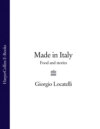Kitabı oku: «Made in Italy: Food and Stories», sayfa 4
Aceto Vinegar

‘A big, big difference to every salad you eat’
As with olive oil, the flavour of vinegar and how much you use of it is quite a subjective thing – if you were to eat a salad dressed the way my mother likes it, you might spit it out, because she loves the flavour of vinegar to come through really strongly. At home in Italy, there will always be one bowl of salad on the table just for her, and a big one for everyone else.
I use very little white wine vinegar; I prefer red wine vinegar, and what I actually like most of all is not officially classed as vinegar in Italy (which by law must have 6 per cent alcohol per volume) but is known as condimento morbido (morbido means ‘soft’). This is brewed in the same way as vinegar but is filtered through wood chips, which smooths it out and takes away some of the sharpness, leaving a ‘condiment’ with lower acidity and alcohol – only 3 per cent.
When we talk about good wine we often think of there being great merit if the production is small and intimate, but with wine vinegar, providing you begin with good grapes, there is no such advantage. You can make millions of litres and still have the same quality; it is like brewing beer. However, you can usually be sure that if you buy vinegar from a producer who makes good wine, the vinegar will also be good quality. People tend to think that it isn’t worth spending a few more pounds on a bottle of good vinegar. But, like I always say when people complain about the price of good olive oil, if you think about how little you use at a time, you are only talking about a few pence, which will make a big, big difference to every salad you eat. And the vinegar isn’t going to go off, unless you actually put it in the sun with the top off and let it evaporate.
Balsamic vinegar, which comes from Modena and the surrounding region of Reggio Emilia, is something completely different, which I use only occasionally and sparingly. As far back as 1046, a visiting German Emperor, Henry II, wrote about a special vinegar which ‘flowed in the most perfect manner’, and it has been eulogised ever since as a mysterious, precious elixir. Originally, it was taken as a tonic as much as it was used in cooking – balsamic actually means ‘health-giving’. However, it remained something of a local secret, made in small quantities that you used when a guest came to visit, or at Christmas, but not every day. In Lombardia, I never saw balsamic vinegar until I was about sixteen and started working in restaurants. We didn’t even have any in the kitchen at La Cinzianella. Then, like sun-dried tomatoes, balsamic vinegar suddenly became fashionable all over the world, and people fell in love with it, using it for everything. Because the traditional production in and around Modena was so small, people began manufacturing it commercially to meet the demand – so now there is great confusion about what is the authentic vinegar, and what is just an industrial product that resembles it. In America, especially, there are even balsamic ‘sauces’, ‘glazes’ and ‘creams’ that you can buy in squeezy bottles, like ketchup.

Unlike other vinegars, true balsamic vinegar is made not from wine but from the must of the Trebbiano grape that has been cooked slowly to concentrate it. This is blended with aged wine vinegar, then matured for at least twelve years in a series or family (‘acetaia’) of barrels, which range downward in size, and are made from different woods (typically oak, cherry, chestnut, mulberry, ash and juniper), so that each adds its own character. Each year, as some of the vinegar evaporates, the smallest barrel is topped up with liquid decanted from the next smallest one, and so on, until finally, the last and largest barrel is topped up with freshly cooked must from the new grape harvest. It is a continuous complex, serious art, which produces a naturally thick, syrupy vinegar with a taste that should have a perfect balance of sweetness and acidity. (The barrels are traditionally stored in attics under the rooftops, where the heat of summer and then the cold of winter are intensified, as this naturally prompts the processes of fermentation and oxidization.)
In 1980 a controlled denomination of origin for the vinegar was set up, and by law, for a vinegar to be called aceto balsamico tradizionale, it has to be produced according to these methods and approved by the Consortium of Producers of Traditional Balsamic Vinegar (Consorzio fra Produttori di Aceto Balsamico Tradizionale di Reggio Emilia). If you are a producer, you must send your vinegar to them; they taste it blind and, if it is good enough quality, and meets all the requirements, they bottle it in their special tulip-shaped bottles. They then mark it with different coloured stamps: red for up to 50 years, silver for a minimum of 50 years, and gold for a minimum of 75 years. Production of this balsamic vinegar is very limited, and for some of the people who supply their vinegar to the consorzio it is almost more of a hobby than a business: some will only make 100 or so bottles a year. We are talking about vinegars that cost up to £100 a bottle, but when you taste the real thing, the experience is extraordinary.
There is another category of balsamic vinegar that is either produced outside the designated region of Reggio Emilia, and so cannot be called ‘tradizionale’, or is made by people who don’t want to deal with the consorzio – maybe they have such a small production that it isn’t worth their while. Or sometimes, producers of ‘tradizionale’ also make other, high quality vinegars that haven’t been aged for so long. Such vinegars must be labelled condimento balsamic vinegar and although they can’t be called ‘tradizionale’ they are made using identical methods, so they can be fantastic quality, and are usually cheaper. I have stayed near Modena and seen people go to the local producers with their own bottles, which the guys fill up for them – and it is beautiful vinegar – but, of course, you have to rely on local knowledge to find out where to go.
The big difficulty is over bottles that are just labelled ‘aceto balsamico di Modena’. Ever since the world ‘discovered’ balsamic vinegar there has been a huge industrial production, which bears no relation to the true artisan product. The legal definition of this vinegar is very loose. Much of it is only white wine vinegar with caramel added. I could make it for you in a pot in the kitchen in 15 minutes – but what an insult to the people who have been making beautiful vinegar in the proper way for hundreds of years. Some of it, though, has been made in a way that is similar to the traditional methods, using at least some cooked grape must, and aged in wood for at least a few years. So how to tell? Often ‘aceto balsamico’ vinegar comes in elegant bottles, sealed with wax, with beautiful labels that suggest ancient traditions, but it is important not to be distracted by the lyrical descriptions that the producers tend to use, and go straight to the ingredients list. The first thing to be listed should be the must of the grape, and there should be no mention of caramel, or any added flavourings. Look for a vinegar that says it has been aged in wooden barrels – as ‘aged in wood’ can sometimes mean wood chips have been added as the vinegar ages.
There is yet another type of vinegar, called vincotto (‘cooked wine’), which is similar to balsamic, made in a serious way but without the ageing and complexity. They say vincotto has its roots in the old Roman tradition of pressing grapes that had been partly dried, then fermenting them to make raisin wine. It became something farmers would make as a sweet dressing for festivals, or as a tonic, but is now being produced commercially, using the Trebbiano grape in the North. As you move further south it is more likely to be made with the Negroamaro and the Black Malvasia, which are left to dry on the vine or on wooden frames before being ‘cooked’ and reduced for 24 hours. The syrup goes into small oak barrels with some of the ‘mother’ or ‘starter’ vinegar from their wine vinegar production, and it is then aged for four years.
In the kitchen at Locanda we use various different balsamic vinegars, and also sometimes vincotto, but for the table we use only the ‘tradizionale’, which we often dispense with great ceremony, using a syringe. It is very expensive but used sparingly it will last you a long time. I would say that if you can only afford to buy one bottle of it in your life, it is worth it, because only by tasting the true traditional vinegar can you begin to understand what balsamic vinegar is about. It is something I would like everyone around the world to experience, because then it can be used as a benchmark by which to judge other, less expensive, balsamic vinegars.
Almost everyone likes the taste of a true balsamic vinegar, kids especially. At one time, the only way we could get my daughter Margherita to eat a green bean salad was to toss it in balsamic vinegar. It is like a natural flavour-enhancer. Good balsamic vinegar needs to be used very simply, though, with specific ingredients. Its combination of sweetness and acidity is at its best with salty, fatty things: so a few drops are perfect with Parmesan, especially the concentrated flavour of an aged cheese. A lovely thing to serve before dinner with an aperitif is just a sliver of Parmesan on a spoon with a drop of vinegar on top. Or sometimes, when we have held parties at Locanda, we have put out half a wheel of Grana Padano cheese, which is similar to Parmesan (see page 209), so that people can pick up small pieces, drizzle over some vinegar and eat it with a glass of Prosecco. I always keep a good bottle of balsamic vinegar at home and sometimes, if I go home late at night from the kitchen, that is all I have – a big wedge of Parmesan with a little vinegar. Since both the cheese and the vinegar originate in the same region of Italy, there is an affinity there that comes with produce of the same land, and so the combination is very satisfying.
Sometimes we make agnolotti with Parmesan, tossed in a little butter, with a couple of drops of balsamic vinegar added; and I love to serve balsamic vinegar with pork belly, or with calves’ liver, in a simple sauce made with sultanas and nuts (see page 484). A little drop is amazing with plainly cooked wild salmon, and balsamic vinegar and strawberries is another famous combination.
I don’t think balsamic vinegar works with bland food. With a cheese like mozzarella, the effect is wasted, and I wouldn’t usually use it to dress a leaf salad, as it loses its impact, unless you are using strongly flavoured leaves like chicory, radicchio or rocket. And I completely disapprove of serving bread with a bowl each of oil and balsamic vinegar – oil yes, but if you dip good bread into balsamic vinegar, you ruin both things. For me it doesn’t work with complicated dishes either. If you were to spoon balsamic vinegar over an elaborate fish dish with lots of different elements, yes, it would add another level of flavour, but again it would be a waste of something special, that deserves to be treated with respect.

Dressings

There is no real Italian equivalent for the word ‘vinaigrette’ because traditionally, when you went into a restaurant and ordered a salad, they would bring the oil and vinegar, and some salt to the table – or if you wanted oil and lemon, you would just ask for olio e limone. Nowadays, if a salad comes ready-dressed, we just borrow the French term. Or we might use the word condimento, which can mean any kind of seasoning or flavouring as well as a dressing; or even aspretto – from aspro meaning sour. We usually use this term when we create a dressing in which there is an element that we have made ourselves – such as our saffron ‘vinaigrette’, which we would call Aspretto di zafferano.
When my brother, Roberto, and I were kids, we were sometimes taken to a local restaurant where dressing the salad was considered a bit of an art. Usually we didn’t want to eat salad at all; we just wanted to watch the waiter perform his ceremony at the table. He would take a silver spoon, put some salt into it, then pour in the vinegar and let the salt dissolve in it. Then he would drizzle a line of oil into the salad bowl and pour in the seasoned vinegar at the same time, so the two met in a stream. Finally, he would put in the leaves and toss everything together in front of us.
The point is that dressing salad leaves should be done at the very last moment before serving, to preserve some crunchiness. Wash the leaves well, trying not to squeeze them, let them drain naturally in a colander, then finish off in a salad spinner. Dress the leaves very lightly so that the dressing just coats them, without drowning, and when you toss everything together, really lift up the leaves so that the dressing coats every single one.
If you are dressing a more complex salad that includes other ingredients besides leaves, think about their consistency before you add the dressing. It is only the delicate leaves that need to be dressed at the last minute, so if, for example, you are making a rocket and tomato salad, the heavier, denser tomato will need more seasoning – earlier – than the rocket. What I would do is put the tomatoes in the salad bowl with some dressing, season them and leave them for ten minutes or so to soak up the flavours and release the juices that the salt will bring out. Then, at the last minute, I would throw in the rocket and toss everything together, adding a little more vinaigrette if necessary – a lovely thing to do at the table.
I can never understand why people buy ready-made vinaigrette in a bottle when there can hardly be anything simpler than mixing together some good oil and vinegar, seasoning it with a little salt (I also add some water, just to soften the dressing), putting it into a bottle with a cork in it and storing it in the fridge. That’s it. My children make vinaigrette at home without even thinking about it. So how can commercial manufacturers tell us that what they put in a bottle is better? Some of them seem to have invented a machine that leaves the dressing in a state of permanent emulsion, which people think must be a good thing. But all you have to do to emulsify a dressing is shake your bottle of oil and vinegar.
There is, of course, no rule that says you must use olive oil for everything – not even in an Italian kitchen would we be that partisan. Sometimes we use other oils, including walnut and hazelnut, to give a different taste to a salad. Just think about your flavours before you add a very distinctive-tasting oil, so that your ingredients and your dressing complement each other and you have no violent clashes.
Giorgio’s vinaigrette
The reason this is called Giorgio’s vinaigrette is not that I am doing anything special – millions of people around the world make exactly the same thing. It just happened that when I was at Zafferano there was a young Algerian chef who could never remember which dressing was which, because we used several in our kitchen. We would shout to him, ‘Vinaigrette!’ and he would say, ‘What does it look like?’ Eventually he stuck a label on each bottle and he called this basic vinaigrette, with oil and vinegar, ‘Giorgio’s vinaigrette’ – so the name has stuck.
I like to mix the vinegar and oil in the ratio of one part to six, but the flavour of vinaigrette is a very subjective thing and everyone has their own ideas. Personally, I don’t like to use a strong Tuscan oil, nothing too peppery and strong for vinaigrette, and you might prefer to add more or less vinegar. It also depends on the quality of the vinegar and its alcohol level. Make up some vinaigrette, taste it and adjust it as you like. The important thing to remember is that if you try it neat, it will taste more powerful than when you mix it with a salad. So, either test it with some leaves, or do what I suggest to my chefs: take a little of the dressing on a spoon, put it into your mouth, then suck it in quickly – it should be sharp enough to make you cough slightly, but not so strong that it really catches in your throat.
Buy the best quality oil and vinegar you can afford, because you can’t put in flavour that isn’t already there. And make up a big bottle, so that you use it all the time. I would be a very happy man if every British family had a bottle of Giorgio’s homemade vinaigrette in the fridge.
Put the salt into a bowl, then add the vinegar and leave for a minute so the salt dissolves.
Whisk in the olive oil and the water until the vinaigrette emulsifies and thickens.
Pour into a bottle, seal and store in the fridge, where it will keep for up to 6 months. It will separate out again into oil and vinegar, so before you use it, just shake the bottle.
Makes about 375ml
½ teaspoon sea salt
3 tablespoons red wine vinegar
300ml extra-virgin olive oil
2 tablespoons water
Aspretto di zafferano Saffron vinaigrette
Makes about 750ml
500ml white wine
150ml white wine vinegar
1 level teaspoon saffron strands
1 tablespoon caster sugar
100ml extra-virgin olive oil
Put the white wine, vinegar and saffron into a pan over a low heat and bring to the boil. Simmer until reduced by three-quarters, then remove from the heat, stir in the sugar until dissolved and leave to cool. Whisk in the oil.
Store the vinaigrette in the fridge, where it will keep for up to 6 months in a screw-topped jar or bottle – or a squeezy plastic one. Take it out of the fridge half an hour or so before you need it, and shake to emulsify before use.
Condimento allo scalogno Shallot vinaigrette
Makes about 250ml
2 banana shallots or
4 ordinary shallots
75ml red wine vinegar
150ml extra-virgin olive oil
salt and pepper
Finely chop the shallots, then put them in a bowl and season with salt and pepper.
Add the vinegar and leave to stand for 30 minutes.
Whisk in the oil and use straight away.
Condimento all’aceto balsamico Balsamic vinaigrette
Makes about 350ml
1 teaspoon salt
250ml balsamic vinegar
100ml extra-virgin olive oil
Put the salt into a bowl, then add the vinegar and leave for a minute so the salt dissolves. Whisk the oil into the vinegar.
This will keep in the fridge for up to 6 months in a screw-topped jar or bottle – or a squeezy plastic one. Take it out of the fridge half an hour or so before you need it, and shake to emulsify before use.
Olio e limone Oil and lemon dressing
Makes about 200ml
pinch of salt
3 tablespoons lemon juice
150ml extra-virgin olive oil
Put the salt into a screw-topped bottle or jar, then add the lemon juice and leave for a minute so the salt dissolves.
Add the oil, put the top on, and shake well to emulsify. It is best to use this dressing immediately.
Maionese Mayonnaise
Makes about 600ml
1 egg yolk
pinch of salt
1 teaspoon English mustard
2 tablespoons white wine vinegar
500ml vegetable oil
juice of ½ lemon
Put the egg yolk in a mixing bowl and break it up a bit.
Add the salt and mustard with half of the vinegar and whisk together for a couple of minutes (this is very important as it helps the mayonnaise to emulsify once you start to put in the oil).
Slowly start to add the oil, whisking continuously, until it is completely incorporated. If it starts to get too thick, add the rest of the vinegar; and if is still too thick add a tablespoon of hot water – just enough to loosen.
When the oil is completely incorporated, add the lemon juice and adjust the seasoning to your taste – add a little more vinegar or lemon juice if you like it a little more sharp.




